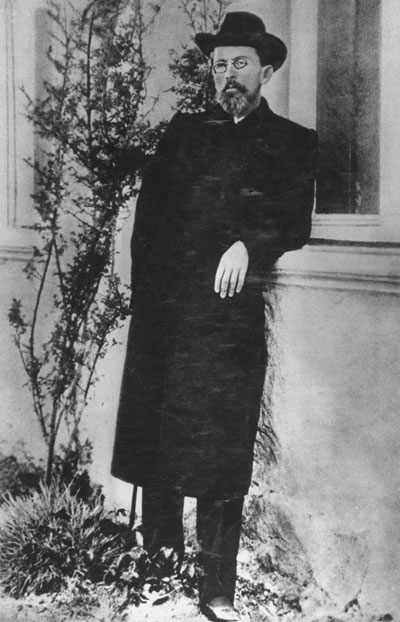One departs and three more come charging in. It’s always rush-hour for Chekhov in the capital. As the Young Vic’s production of Three Sisters is drawing to a close, the Vaudeville is preparing to host a star-studded version of Uncle Vanya. Up the road, at the Novello, another Uncle Vanya is about to arrive from Moscow. And rehearsals are already under way for The Seagull, starring Matthew Kelly, at Southwark Playhouse. For years, we’ve been recreational users of Chekhov. We’re now in danger of becoming hopeless addicts. How come we’re hooked?
Chekhov’s career as a dramatist was short and full of trouble. Early plays flopped. His breakthrough hit, The Seagull, also bombed when it was first performed in 1896 at the highly traditional Alexandrinsky Theatre in St Petersburg. Two years later, a revival at the more progressive Moscow Arts Theatre was a surprise success. Chekhov followed it up with Uncle Vanya (1899), Three Sisters (1901) and The Cherry Orchard (1904). Then he died.
His naturalistic style was something new in the theatre. Rather than creating rowdy, dashing heroes and elaborate cliffhanging plots, he set out to depict the slow, ticking banalities of everyday life in the Russian provinces. When the director Peter Brook first saw Chekhov, he said it was like listening to a tape recorder that had been accidentally switched on during a family argument. To modern audiences, raised on reality TV and soap operas, this humdrum realism is already in tune with our aesthetic expectations. So we approach these towering foreign masterpieces with an easy mind. They’re classics but they haven’t the scariness or the exalted pretensions of ‘classic’ classics. And because Chekhov wrote just four great plays we can complete the set over a long weekend. To do that with Ibsen would take a fortnight. With Shaw, three weeks. Shakespeare would require a month.
Chekhov flatters us. He flatters everyone, thesps, play-goers, designers, producers. That’s the secret of his popularity. He flatters directors by offering them an enormous range of targets to hit. The plays, which are impossible to classify, belong to a unique genre. They’re romantic tragicomic documentary meditations on the futility of existence. And it takes a seriously incompetent director to fail in every one of these registers. Chekhov reassures audiences by remaining utterly resistant to conceptual experiment. To my knowledge, no one has tried to stage his work in Nazi Germany or missile-crisis Cuba or Stone Age Mesopotamia. The plays remain where they were born in fin-de-siècle Russia.
Happily, it was an age of exceptional domestic elegance and this gives the set designer a very easy time. All it takes is a trip to a Victorian knickknackery, and the removal of the entire stock into a waiting van, and the task is complete. Audiences are bound to find the results ravishing because those antique hardwood interiors gratify our secret longing for the wardrobe-crammed comforts of our grandparents’ houses.
The colour schemes are similarly undemanding. Indoors, the palette is sombre brown, which can be varied with lighter notes of yellow, grey and off-white. Outdoors, the sun is probably setting so the essential hue is faded amber, which creates an instant mood of crumbling grandeur. And of all the colours on the spectrum, amber is the easiest to beautify. You just add discreet hints of its chromatic complement, azure. The result — blue-orange — is exquisite to look at even though it’s as laughably unadventurous as a recipe consisting of coq and vin. But this is Chekhov. Novelty and innovation would be as outlandish here as a casino in a graveyard.
The money men are bewitched by Chekhov as well. Three of his plays offer the sort of cross-generational pairings that impresarios love. Uncle Vanya requires the services of a grizzled TV lothario in the title role. And he can be matched with an upcoming Brit-flick beauty as Yelena. The Seagull has a similar pattern with the genders reversed. A comedy yob plays Konstantin and an ageing stunnah takes on Arkadina. Same goes for The Cherry Orchard. The bankrupt dowager, Ranevskaya, can be performed by a household facelift while Lopakhin, the ambitious peasant, is ideal for some flavour-of-the-month gag merchant from QI or Mock the Week. Chekhov spreads his gifts generously and even the smaller roles attract talented performers. John Gielgud, at the height of his powers in 1961, was happy to play the ageing buffoon, Gaev, in a production of The Cherry Orchard at the Aldwych Theatre.
Actors love Chekhov because he lets them do what they love best: to express beautiful thoughts while prancing about in attractive togs. In pre-Bolshevik Russia, everyone is dressed for a party. The gentlemen wear white flannel suits with a silk cravat, a straw boater and perhaps a pipe. For dinner, they change into full Bullingdon rig. The men-servants, in scuffed shoes and moth-eaten tailcoats, suggest a certain trampish elegance. The serfs look good, too. The beard, the belted smock and the Joe Orton cap create a glamorous fusion of late Tolstoy and early grunge.
And let’s not forget the ladies. Their necks and fingers twinkle with soon-to-be-pawned diamonds. Their hair is gathered and pinned into frothing soufflés of curled tresses. And they glide around the stage in those sweeping floor-length frocks that seem to flatter every figure — even stick-thin dwarfs and ‘danger-to-shipping’ heavyweights. And the modern audience unconsciously registers the long-sleeved Edwardian gown as the symbolic attire of the Suffragettes, so female characters in Chekhov are instantly credited with brains, eloquence and cockiness. To us they look like feminists who haven’t lost their femininity.
And this is Chekhov’s most exquisite beguilement. Somehow he makes his drunken fools, his champion bores and his sighing provincial heiresses feel like our intimate friends. The first Chekhov I ever saw was an am-dram production of Three Sisters in the Fulham Road. It was shoddily designed, chaotically lit and shambolically acted but I loved every minute of it. The eccentric forcefulness of Chekhov’s world overpowered me. I didn’t just want to watch these garrulous, self-deluding twerps; I wanted to join them and be there, too. Chekhov consoles us theatre-goers for all the country-house parties we never get invited to.
There’s nothing wrong with succumbing to Chekhov’s non-stop charm offensive. The only danger is that we’ll become too easily satisfied with a butter mountain of comfort-food theatre. And we might, if were feeling virtuous, try to purge our systems with a period of Lenten austerity and give Chekhov the brush-off for a month or two. But in practice, we can’t get enough of him.







Comments